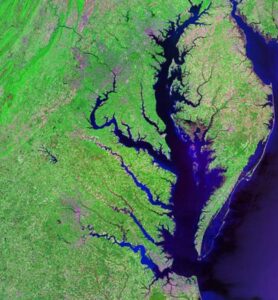 January 20, 2023: A.J. Metcalf, Maryland Media & Communications Coordinator, Chesapeake Bay Foundation (CBF)
January 20, 2023: A.J. Metcalf, Maryland Media & Communications Coordinator, Chesapeake Bay Foundation (CBF)
Maryland Gov. Wes Moore’s newly released state budget includes funding for several high priority initiatives to improve Chesapeake Bay.
The Fiscal Year 2024 budget provides 43 new positions and $3.7 million in funding for the Maryland Department of the Environment (MDE) to enable the agency to close the extensive backlog of administratively continued pollution discharge permits.
CBF along with other environmental organizations have called on the state to review these so-called “zombie permits” because their pollution limits are often outdated and poorly enforced. The new MDE inspectors will help ensure that industrial and other types of facilities that are permitted to pump polluted water directly into the state’s waterways are complying with environmental regulations, which could reverse the state’s 20-year decline in clean water enforcement activities.
Gov. Moore’s budget also includes $15 million to implement the Tree Solutions Now Act of 2022, which requires the state to plant 5 million trees by 2030, including 500,000 in underserved urban areas. The funding will support farmers and community-based organizations interested in planting trees. Planting new trees is one of the most cost-effective ways to limit Chesapeake Bay pollutants and mitigate climate change in cities and on agricultural lands.
The budget also allocates $2 million for a new Chesapeake Bay bottom geological survey, which aims to overhaul maps last updated in the 1970s and 1980s that are used to make decisions about oyster management and other issues. CBF has previously urged officials to conduct the survey to better understand where potential oyster restoration projects could have the most success.
Gov. Moore’s first budget also allocates significant funding to helping the state meet requirements of the newly established Climate Solutions Now law. This includes a $13.8 million increase for state renewable energy programs and a $15.7 million increase in the state’s energy efficiency grants program.
Taken together, these initiatives will help Maryland accelerate progress to reach the 2025 Chesapeake Clean Water Blueprint during a time when cleanup efforts are struggling. CBF’s State of the Bay report graded the overall health of the Bay as a D+, marking the third time in a row the grade in the biennial report has not changed.
In response, CBF’s Interim Maryland Executive Director Erik Fisher issued the following statement:
“This budget includes important investments that follow through on commitments made for Maryland’s environment. The new funding and staff for MDE’s enforcement programs are sorely needed to address the lack of oversight resulting from outdated permits spanning nearly two decades. Investments in tree plantings will help Maryland mitigate the effects of climate change, put more natural air and water filters throughout the landscape, and beautify our communities. The Bay bottom survey will give us a clearer view of the status of the Bay’s underwater habitats and the potential for future oyster restoration in Chesapeake Bay.
“The new budget represents a strong start for the environmental initiatives being pursued by Gov. Moore, Lt. Gov. Miller, and the administration. We’ll continue to watch the budget process closely to ensure programs for clean water are supported and fully funded as the budget makes its way through the General Assembly.”
About CBF: Founded in 1966, the Chesapeake Bay Foundation is the largest independent conservation organization dedicated solely to saving the Bay.
Serving as a watchdog, we fight for effective, science-based solutions to the pollution degrading the Chesapeake Bay and its rivers and streams. Our motto, “Save the Bay,” is a regional rallying cry for pollution reduction throughout the Chesapeake’s six-state, 64,000-square-mile watershed, which is home to more than 18 million people and 3,000 species of plants and animals.
With offices in Maryland, Virginia, Pennsylvania, and the District of Columbia and 15 field centers, CBF leads the way in restoring the Bay and its rivers and streams. For more than 50 years, we have created broad understanding of the Bay’s poor health, engaged public leaders in making commitments to restore the Chesapeake, and fought successfully to create a new approach to cleanup that features real accountability—the Chesapeake Clean Water Blueprint.
But the Bay is still a system dangerously out of balance. We continue to engage in education, advocacy, litigation, and restoration to turn the tide and leave a legacy of clean water for future generations.


